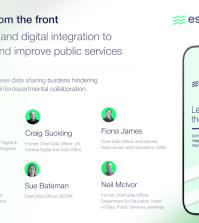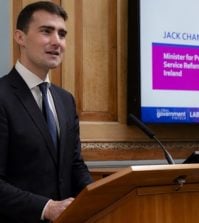Strategy school: digital leaders debate how to drive transformation

At the Global Government Digital Summit, digital leaders from around the world discussed how – and whether – to produce a digital strategy, and pitched their ideas on how best to build support, secure funding and reform commissioning. Matt Ross reports
“A few years ago, the Icelandic government realised that we had to take a completely different approach to digital transformation,” said Andri Heiðar Kristinsson. Within the Ministry of Finance and Economic Affairs, “it was decided to create this task force, Digital Iceland, which I lead now. And by design, it was created outside any legal framework; it didn’t fit into the organisational chart of the government or the ministry. It’s been designed to have more flexibility; more autonomy”.
Addressing 30 digital leaders from 12 countries at the 2022 Government Digital Summit in Ottawa, Kristinsson was speaking in the session on ‘Creating and Transforming Interdepartmental Services’. Central digital units such as his have a crucial role to play in supporting partnership working between departments developing new services, and the typical response, he noted, is to start by producing a digital strategy.
Not in Iceland: “I was explicitly told when I started my job: ‘Do not start with a strategy. We want you to start by doing things’,” Kristinsson recalled. “The focus initially was very much on some of the low-hanging fruits, like the digital driver’s license: something enabling the politicians to say: ‘We did that!’, and to build out that credibility.” It was 18 months later that “we decided to sit down and write the strategy, based on what we’d learned and what we were executing”.
Managing strategies strategically
That approach made a lot of sense to another participant, the CIO of a government department. On joining the department, they recalled, they found that it had “had seven CIOs in seven years, all of whom had brought their own strategy – and the organisation kind of had whiplash!” They decided instead to “evaluate the organisation, and then do the strategy; and I got a lot of pushback on that. Nine months in, somebody said to me: ‘I’m really worried about your legacy here, because you don’t have a strategy’.” For the speaker, this was not a concern; the priority at that time was active change, not high-level strategising.
The risk in producing a digital strategy “without real clarity around the mission and vision of what you’re trying to achieve”, commented US federal chief information officer Clare Martorana, is that of generating “a wonderful white paper that goes on a shelf someplace”. Too often, she added, such strategies contain policies that “are not implementable, with agencies given unfunded mandates without the budget or the personnel or the talent to execute with excellence”.
As a self-confessed “implementation nerd”, Martorana instead produced an IT Operating Plan. “It’s very tactical; it was designed to show how we flow money through those organisations in order to enable technology delivery,” she explained. Leveraging the strength of working as a collective team across three funding organisations, the Operating Plan explains how each organisation will use their unique “super powers” – developing modern tech policies, tech strategies, and longer-term technical services – to support agencies in delivering better products and services for Americans.
Securing support
Other countries are at a different stage – and Megan Lee Devlin, chief executive of the UK’s Central Digital and Data Office (CDDO), commented that the UK recently produced quite a detailed roadmap for 2022-25: ‘Transforming for a Digital Future’. Since 2010, the UK has led the way in some aspects of digital delivery: Lee Devlin cited its service standards and spend controls, gov.uk, and new services such as the furlough scheme, COVID-19 app and EU Settlement Scheme. But a CDDO review of government’s most important digital services found that only “10% are great when compared to industry best practice measures of usability and efficiency; progress has been uneven”. CDDO is working closely with departments to meet the government’s goal of transforming 50 of the top 75 services to a ‘great’ standard by 2025, Lee Devlin said.

The CDDO concluded that “our focus should be on putting the foundations in place – addressing some of the systemic blockers that have stopped us from scaling digital transformation,” said Lee Devlin. To achieve the transformation to which the UK government aspires, “we need to secure the business ownership of leaders right across government; the National Audit Office pointed out that we have not achieved that to date. Rule number one in the playbook is to get your most senior business leaders on board”.
So the Roadmap has been co-created with a Digital and Data Board: “a forum of permanent secretaries that get together quarterly, and discuss progress against the strategy.” The planning process involved “a lot of analysis, discussion and debate on what would constitute an ambitious but achievable plan”, explained Lee Devlin. Discussions were then held with other key leaders – such as the CIOs and chief operating officers – to “make sure it was not just designed by the centre, but something we all owned, believed in and could deliver”. Ultimately, said Lee Devlin, the result is a plan designed and led by the departmental leaders: “The intention was to gain alignment: to demonstrate that collectively we are more than the sum of our parts – and, crucially, to highlight where we wanted to work more closely together going forwards.”
Facilitating funding
As Martorana’s and Lee Devlin’s comments make clear, securing and allocating funds is key to ensuring that lofty ambitions translate into active delivery. GGF’s latest Digital Leaders report explains that digital leaders have struggled to attract capital investment in recent years; but the pandemic has helped to shift attitudes among elected leaders. Governments’ dependence on digital technologies to protect households and jobs helped both to catalyse progress on digital, said Martorana, and to demonstrate the value of investing: “We were able to deliver in a matter of days and weeks services that we’d been attempting to deliver for many years.”
The growing threat of cyber-attacks, Martorana added, has also hit home with elected leaders – many of whom recognise the need to address the “threat landscape that we’re navigating: the daily assaults on all of our agencies and infrastructure”. Explaining the volume and sophistication of cyber attacks on US federal systems, she said, has helped bolster digital budgets – funding reforms that also transform public services. “Cyber-security is the point of our spear, carrying behind it customer experience and IT modernisation,” she commented.

In the UK, Lee Devlin explained, the CDDO is developing “data maturity indices, a common framework for looking at legacy risk across departments, and a common way of measuring service performance” – enabling the CDDO and Treasury to target support, assurance and capital investments. Working with departments, the CDDO assists with planning and delivery, and holds departments to account through quarterly business reviews. It can also use its ‘spend controls’ to block projects that contravene the Roadmap, explained Lee Devlin, “but our aspiration is to make sure that we’re on the same page from the get-go, instead of using that backstop”.
Buy the way: reforming procurement
Departments do need assistance as they wrestle with large-scale digital transformation projects. In Iceland, commented Kristinsson, many “don’t have the in-house capability” to manage delivery – “so at the moment, we’re stepping in and doing a lot of that for them”. A unique tender gives Digital Iceland access to a set of private companies that can be deployed to support the agencies, supplying highly-qualified teams to deliver individual ‘sprints’ within host departments.
“So if I have a new project that looks good, I can deploy a team within a matter of days,” he said. “That’s completely changed how we do things.” Digital Iceland is now considering a certification scheme for suppliers, creating a roster of “preferred partners” with the skills and expertise to operate effectively in government.
The agency has also changed the way in which it selects which projects to support, Kristinsson explained. “Initially, we went top-down and said: ‘We want to start working on this service’,” he recalled. “Now we’ve flipped the model, and say the agencies have to come to us – then it’s their initiative and their idea to work with us, and we’re just here to help. It works a lot better that way.”
Kevin Cunnington, former director general of the UK’s Government Digital Service (GDS), recalled another innovative way of commissioning digital services. Under the UK’s Innovation Fund, he explained, “we were allowed to commission up to five vendors, and only take two forwards. So we built 60% redundancy into our experimentation”. This approach permitted GDS to test a range of solutions to a problem, getting away from a situation in which the agency would be required to “put all our eggs in one basket. It was a real sea change in the UK philosophy”.
The Canadian province of British Columbia uses a similar technique, commented Kirsten Tisdale, managing partner at EY Canada: “They call it ‘Sprint With Us’: the government throws out a problem, and pays teams to work on it,” she explained. “Then they select two or three teams to move forward with, providing what is essentially an innovation and development service to design and deliver new functionality and capability. They are buying high performing teams to co-develop and deliver solutions with them. It’s working really well in British Columbia.”
Contracting and procurement arrangements can also be reformed to increase agility and flexibility, said Tisdale. Contracts can, for example, reserve the right to run multiple suppliers simultaneously, or include prenegotiated terms and conditions permitting their extension to other government departments. “Then you avoid having to go back to procurement over and over again for the same solution,” she said. “And if firm number one stumbles, you can bring in firm number two, or allow them to come up with different parts of the solution. So you open up the field, and also create some competitive tension.”
On a broader front
Such initiatives can help to get around some of the problems in civil service project management and procurement – but as Megan Lee Devlin acknowledged, wider reforms will be required before government can transform at scale. “The business and the system of government isn’t designed for agile teams,” she commented. “But we’re working with Treasury to modernise our approach to funding. We’re working with finance to shift the way they think about agile when it comes to risk. We’re working with the IPA, our projects authority, to make sure that digital is a really core part of the methodology taught to our project leaders. We’re linking in with our policy colleagues, so that user-centred design, cross-functional teams and data-driven decision-making are more common. And we’re working with the commercial function, to ensure that we make it as easy as possible for government to work with suppliers on the right solutions.
“So there’s a lot to be done. But our aspiration is to move away from pockets of progress to enduring transformation, and this is what it’s going to take,” she concluded. Through the Roadmap process, CDDO has helped departmental leaders to “understand that this is no longer optional: that people expect much better from government, and that they deserve to receive that too. And we’ve moved away from disrupting from the outside, from being the ‘other’, to meeting colleagues half-way, and changing the system that we operate within so that we can achieve that enduring transformation.”
The 2022 Global Government Digital Summit was hosted by the Government of Canada in Ottawa in October. This article covers the event’s third session. The first article covered the evening session, including the responses to one digital leader’s plea for assistance; the second examined the discussions on developing digital ID systems; the fourth explored the digital workforce; and the fifth covered the debate on how best to transition from legacy systems.
Although the Summit is a private event, GGF produces these reports to share as much of the discussions as possible with our readers – checking before publication that participants are happy to be quoted.
Visit https://digital.globalgovernmentforum.com/ to learn more about the Summit.
Want to write for GGF? We are always looking to hear from public and civil servants on the latest developments in their organisation – please get in touch below or email [email protected]























